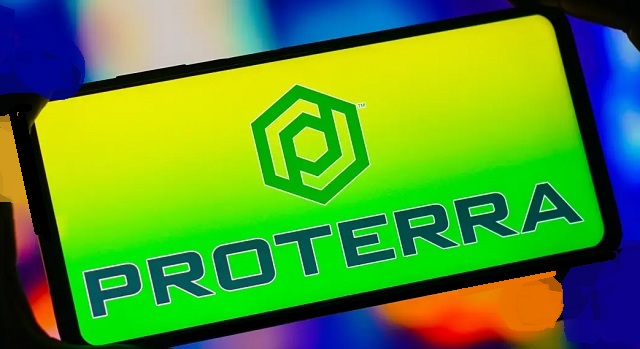Biden’s Build Back Bust: Electric Car Company Proterra Goes Belly-up Bankrupt
By Dr. Rich Swier

The center piece of Joseph Robinette Biden, Jr.’s Build Back Better all electric vehicles GREEN agenda is a BIG bust.
Biden’s Build Back Bust economy has led to, among others, the bankruptcy of Proterra the maker of all electric buses.
WATCH:
During his first two years in office, Biden repeatedly promoted the company Proterra, including virtually touring their factory. He touted the company as the “future.”
Yesterday, Proterra declared bankruptcy. pic.twitter.com/snkcvYf6KM
— GOP (@GOP) August 8, 2023
The New York Post’s Josh Christenson reports,
President Biden frequently extolled an electric vehicle company — in which his energy secretary heavily invested — before it declared bankruptcy on Monday.
Bay Area-based electric bus and battery maker Proterra filed for Chapter 11, with CEO Gareth Joyce citing “various market and macroeconomic headwinds that have impacted our ability to efficiently scale.”
The EV firm, which sold more than 1,300 electric buses to public transit systems in the US and Canada, was valued at $1.6 billion when Biden, 80, took office in January 2021 — but closed with a market value of $362 million, according to Reuters.
In 2021, the president pledged more than $10 billion from his $1.9 trillion bipartisan infrastructure plan toward zero-emission transit and school bus programs.
He has promoted Proterra several times since taking office, and once virtually toured a facility.
It is a fact that all Electric Vehicles (EVs) are powered by coal, uranium, natural gas or diesel-powered energy sources.
One of the greatest persistent, persuasive and unrealistic myths is the idea that the United States must abandon coal, fossil and nuclear fuels in favor of windmills and solar panels. This persistent, persuasive and unrealistic myth is now public policy!
The The Biden-Harris Electric Vehicle Charging Action Plan states,
President Biden has united automakers and autoworkers to drive American leadership forward on clean cars, and he set an ambitious target of 50% of electric vehicle (EV) sale shares in the U.S. by 2030. Now, the Bipartisan Infrastructure Law will supercharge America’s efforts to lead the electric future, Building a Better America where we can strengthen domestic supply chains, outcompete the world, and make electric cars cheaper for working families.
[ … ]
The Bipartisan Infrastructure Law makes the most transformative investment in electric vehicle charging in U.S. history that will put us on the path to a convenient and equitable network of 500,000 chargers and make EVs accessible to all Americas for both local and long-distance trips. The Bipartisan Infrastructure Law includes $5 billion in formula funding for states with a goal to build a national charging network. 10% is set-aside each year for the Secretary to provide grants to States to help fill gaps in the network. The Law also provides $2.5 billion for communities and corridors through a competitive grant program that will support innovative approaches and ensure that charger deployment meets Administration priorities such as supporting rural charging, improving local air quality and increasing EV charging access in disadvantaged communities. Together, this is the largest-ever U.S. investment in EV charging and will be a transformative down payment on the transition to a zero-emission future. [Emphasis added]
QUESTION: What exactly will charge the chargers and the batteries in these clean cars?
EVs Are Not So Green
A reader send us a link to this post on Reddit:
Not so Green
This is an excellent breakdown.
Batteries, they do not make electricity – they store electricity produced elsewhere, primarily by coal, uranium, natural gas-powered plants, or diesel-fueled generators. So, to say an EV is a zero-emission vehicle is not at all valid.
Also, since forty percent of the electricity generated in the U.S. is from coal-fired plants, it follows that forty percent of the EVs on the road are coal-powered, do you see?”
Einstein’s formula, E=MC2, tells us it takes the same amount of energy to move a five-thousand-pound gasoline-driven automobile a mile as it does an electric one. The only question again is what produces the power? To reiterate, it does not come from the battery; the battery is only the storage device, like a gas tank in a car.
There are two orders of batteries, rechargeable, and single-use. The most common single-use batteries are A, AA, AAA, C, D. 9V, and lantern types. Those dry-cell species use zinc, manganese, lithium, silver oxide, or zinc and carbon to store electricity chemically. Please note they all contain toxic, heavy metals.
Rechargeable batteries only differ in their internal materials, usually lithium-ion, nickel-metal oxide, and nickel-cadmium. The United States uses three billion of these two battery types a year, and most are not recycled; they end up in landfills. California is the only state which requires all batteries be recycled. If you throw your small, used batteries in the trash, here is what happens to them.
All batteries are self-discharging. That means even when not in use, they leak tiny amounts of energy. You have likely ruined a flashlight or two from an old, ruptured battery. When a battery runs down and can no longer power a toy or light, you think of it as dead; well, it is not. It continues to leak small amounts of electricity. As the chemicals inside it run out, pressure builds inside the battery’s metal casing, and eventually, it cracks. The metals left inside then ooze out. The ooze in your ruined flashlight is toxic, and so is the ooze that will inevitably leak from every battery in a landfill. All batteries eventually rupture; it just takes rechargeable batteries longer to end up in the landfill.
In addition to dry cell batteries, there are also wet cell ones used in automobiles, boats, and motorcycles. The good thing about those is, ninety percent of them are recycled. Unfortunately, we do not yet know how to recycle single-use ones.
But that is not half of it. For those of you excited about electric cars and a green revolution, I want you to take a closer look at batteries and also windmills and solar panels. These three technologies share what we call environmentally destructive production costs.
A typical EV battery weighs one thousand pounds, about the size of a travel trunk. It contains twenty-five pounds of lithium, sixty pounds of nickel, 44 pounds of manganese, 30 pounds cobalt, 200 pounds of copper, and 400 pounds of aluminum, steel, and plastic. Inside are over 6,000 individual lithium-ion cells.
It should concern you that all those toxic components come from mining. For instance, to manufacture each EV auto battery, you must process 25,000 pounds of brine for the lithium, 30,000 pounds of ore for the cobalt, 5,000 pounds of ore for the nickel, and 25,000 pounds of ore for copper. All told, you dig up 500,000 pounds of the earth’s crust for just – one – battery.”
Sixty-eight percent of the world’s cobalt, a significant part of a battery, comes from the Congo. Their mines have no pollution controls, and they employ children who die from handling this toxic material. Should we factor in these diseased kids as part of the cost of driving an electric car?”
I’d like to leave you with these thoughts. California is building the largest battery in the world near San Francisco, and they intend to power it from solar panels and windmills. They claim this is the ultimate in being ‘green,’ but it is not. This construction project is creating an environmental disaster. Let me tell you why.
The main problem with solar arrays is the chemicals needed to process silicate into the silicon used in the panels. To make pure enough silicon requires processing it with hydrochloric acid, sulfuric acid, nitric acid, hydrogen fluoride, trichloroethane, and acetone. In addition, they also need gallium, arsenide, copper-indium-gallium- diselenide, and cadmium-telluride, which also are highly toxic. Silicon dust is a hazard to the workers, and the panels cannot be recycled.
Windmills are the ultimate in embedded costs and environmental destruction. Each weighs 1688 tons (the equivalent of 23 houses) and contains 1300 tons of concrete, 295 tons of steel, 48 tons of iron, 24 tons of fiberglass, and the hard to extract rare earths neodymium, praseodymium, and dysprosium. Each blade weighs 81,000 pounds and will last 15 to 20 years, at which time it must be replaced. We cannot recycle used blades.
There may be a place for these technologies, but you must look beyond the myth of zero emissions.
“Going Green” may sound like the Utopian ideal but when you look at the hidden and embedded costs realistically with an open mind, you can see that Going Green is more destructive to the Earth’s environment than meets the eye, for sure.
The Bottom Line
EVs are neither carbon-neutral nor powered by batteries. The batteries in EVs are all powered by other energy sources. The truth is that mankind cannot become carbon neutral without hurting mankind itself.
We have long recommended that America go all nuclear power. Nuclear power is clean, carbon free, reliable and cheap.
As we wrote in our column “America’s Energy Future: Oil, Natural Gas and Nuclear“:
America’s power lies in its ability to provide power to the engines of our current and future economic growth.
Starving America of power, makes America powerless. Starving our citizens of cheap and reliable power is a direct threat to our fiscal and national security.
To be powerful America needs powerful sources of energy. Nuclear, oil (for gasoline, diesel and aviation fuels) and natural gas are the best and most accessible means to energy independence.
Energy independence translates into life, liberty and the pursuit of our collective happiness.
Without cheap and reliable power sources the lights in that city on the hill will most certainly go out – for everyone.
Powerup America.
©2023. Dr. Rich Swier. All rights reserved.
RELATED ARTICLES:

This article is courtesy of DrRichSwier.com, an online community of citizen journalists, academics, subject matter experts, and activists to express the principles of limited government and personal liberty to the public, to policy makers, and to political activists. Please visit DrRichSwier.com for more great content.

